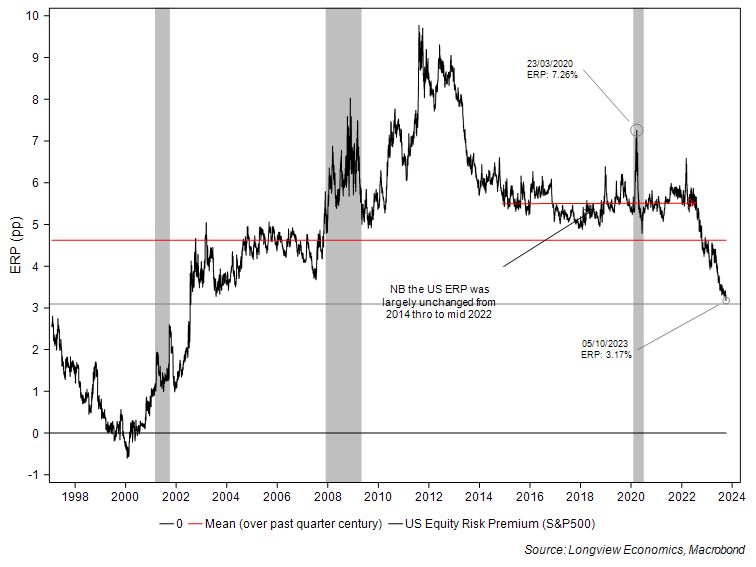The market metric seldom discussed (and why it matters)
The most important financial indicator right now may not be the level of government bond yields, or the implications from weak leading economic indicators, not even the fact that forecasts for US corporate earnings for the two calendar years ahead seem more like pie in the sky.
The most important indicator, possibly, is one the average investor is rarely confronted with; the equity risk premium, or ERP.
This indicator is not often mentioned or reported on by mainstream media, let alone your average tip sheet or investment newsletter. But it has been front of mind for many professional asset managers and investors over the past 18 months or so. A much lower than usual ERP is also what has the more cautious professional concerned about what 2024 might have in store for equity markets and investment portfolios.
The equity risk premium is essentially the added certainty investors require from listed equities in comparison to lower risk US government bonds. Put differently: equities should always trade at a relative discount to compensate for the additional risk. According to investment theory, the ERP should widen and narrow as risks for economies and corporate profits and dividends rise and subside.
Usually, this is what happens, though timing and duration of these moves remain anyone's guess during the best of times. Which is why the ERP is usually only discussed by erudite share market experts and detail-minding investment committees. There are no predictive powers to be gained from it and most conclusions can only be accurately drawn in hindsight.
But like with most financial indicators, when extreme levels appear on screens, that's when broader interest is awoken too.
A brief look over our shoulder shows when the ERP peaked in times of general crisis, the timing was right to prepare for the next rally in equities, as happened in 2020, in late 2018, in 2011, and in late 2008.
This time around, however, the ERP has not widened significantly as one would have expected given the uncertainty from rapid central bank tightening, rising bond yields, a global mountain of debt and increasing geopolitical tensions.
Over the past two years the ERP has shrunk, and quite noticeably too.
This is the reason as to why many are calling equities "overvalued" or "expensive", because on a relative comparison with US government bonds, they seem pricey with today's ERP at its lowest level since the global bear market of 2000-2002. Graphic below courtesy of Longview Economics.
.jpg)
If history had repeated throughout the past 18 months or so, the ERP should have gone up (wider) not down (narrower) and the impact on equities would have been significant, potentially a la GFC and Nasdaq meltdown back in 2008/09 and 2000/02 respectively. This immediately explains why forecasts for a more dire bear market to develop in 2022 never materialised.
In hindsight.
The problem with today's set-up is nobody genuinely knows why the ERP has shrunk as much as it has, and why it is at the low level where it is today. But everybody agrees today's ERP enigma represents somewhat of a conundrum. To justify it, corporate earnings need to accelerate by 20%, which seems rather unlikely given the outlook of decelerating economic momentum worldwide.
Another scenario is for bonds to start rallying, strongly, and thus for bond yields to drop significantly. As every investor has witnessed over the past two months or so, the opposite is currently happening. Central bankers are in no mood to allow the inflation genie too much leeway and markets have reset for a higher-for-longer outlook for central bank rates and government bond yields.
We can all see the conundrum, can't we?
If bond yields stay high, or rise even further, and the ERP moves back to the level it was at the start of 2022, equities need to devalue by -20%. This is not taking into account the possibility of economic recessions, and further downgrades to corporate earnings forecasts, or the fact such corrections to the downside always extend further as panic kicks in and more weakness begets more selling, which begets more selling and more weakness.
Don't press that panic button just yet!
As indicated, I have yet to see anyone providing a watertight explanation as to why the ERP has shrunk so much during a time when a much larger premium (larger discount for equity valuations) would have seemed but logical and justified. My own explanation, which I haven't as yet seen mentioned anywhere else, is that maybe the answer lays with the bond market, not with corporates and their equities?
Most equity investors would be oblivious to how horrid the past two years have been for fixed income investors and their portfolios. Many an informed commentator has drawn comparisons with the impact from the GFC or the Nasdaq meltdown on equities. US government bonds are on course for the second year in a row of double-digit losses, the third consecutive year of negative return.
As far as we can establish today, this probably has never, ever happened in history.
Is it possible such a terrible time for the less risky government bond market has in effect reduced the gap in risk vis a vis equities?
If the answer is 'yes', this still does not solve the conundrum. After three years of negative return, bond markets are arguably approaching their bottom in pricing and their peak in yields. This automatically implies they become less risky, and overall volatility should subside.
Once this process unfolds, investors will start feeling a lot more comfortable with allocating more money into fixed-interest products, including US government bonds.
Can everyone see the conundrum?
If the next step implies government bonds have become less risky and thus the ERP is too low, this cannot possibly be great news for share markets - all else remaining equal. In the absence of a sharp acceleration in corporate profits, bond yields need not simply to come down, they need to pull back significantly to justify today's ERP, but they probably will only do so when triggered by significant economic duress, like a recession.
Another factor that might prove important is that share markets are hardly homogenous, both in Australia as well as in the US and elsewhere. While we're all too aware that US indices have enjoyed the benefits from a small group of energy, Megatech, anti-obesity and AI-driven outperformers, the impact on the ASX share price performances to date has equally proven as polarised, leaving many share prices, and valuations, well below the average.
This in itself offers up multiple scenarios and avenues for markets to push back today's ERP to its previous average or thereabouts, if this is what needs to happen. It's always dangerous to declare this time is different, but in the same vein: there's no time limit given as to when this process of relative valuation normalisation needs to be completed.
In Australia, as well as in the US, market sentiment and money flows have largely concentrated around companies larger in size, generally speaking. There are always pockets available for short-term traders and market speculators, but generally speaking, large caps have outperformed mid-caps, which have outperformed small caps, which have outperformed micro-caps.
And this in a market in which year-to-date total return for the ASX200 is only positive, barely, because of world-class dividends paid out to shareholders.
Another observation is traditional defensives have turned into laggards thus far, which can also be observed through the share prices of Telstra ((TLS)), CSL ((CSL)), Transurban ((TCL)) and Woolworths Group ((WOW)). Rising bond yields have not been the only driver responsible, but they have been a significant and easily identifiable factor.
Equally notable is the remarkable resilience on display from shares in the likes of REA Group (ASX: REA), Audinate Group (ASX: AD8) and Pro Medicus (ASX: PME ); stocks local investors simply do not like to dispose of. The same questions surround the winners on Wall Street: is this just a temporary phenomenon, or a loyalty that can withstand further troubles and volatility?
According to Morgan Stanley's fixed income team, the movements in US Treasuries post the September FOMC meeting equal three Fed rate hikes of 25bp each, suggesting the noose is tightening for US economic momentum. In Australia, the RBA is suggesting it may not be done tightening just yet.
At some point, we have to assume, this will be reflected in economic data and in corporate earnings. Bond yields should start trending lower.
The exact timing of events will be of influence to any normalisation in the ERP. Plus lower bond yields will most likely be only one of the factors driving this process, with lower earnings driving lower share prices as a logical co-contributor. Today's markets are heavily bifurcated, implying there are many different ways in which ERP normalisation can be achieved.
While it cannot be excluded this process also includes a nasty, sharp de-rating of equities, exact trigger as yet unknown, we won't know until it has happened because the ERP offers investors nil predictive powers.
Inflation is also still in the mix and a protracted war with reduced supplies of crude oil and gas remains a potential scenario-influencer.
In Australia, the major index is more or less trading in line with its long-term average PE ratio of circa 14.5x. Earnings estimates continue to be under pressure with the current market forecast for negative -5.7% EPS growth in FY24, expected to be followed up with a positive 5.7% in FY25.
The average dividend yield is 4.3% only (forward-looking), below the long-term average of 4.6%. All aggregate numbers are, as usual, heavily dependent on what happens with BHP Group ((BHP)) and other miners and energy companies.
To date, the out-of-season reporting by companies in Australia, including investor presentations, quarterly trading updates and AGM outlooks remains a smorgasbord of confirmations, upside surprises and downside adjustments, without providing clear visibility in the underlying economic trajectory for the months ahead.
The sum of all of the above suggests strong and resilient economies for longer may, oddly enough, not be the ideal outcome for equities, but then nobody said the traditional cycle is dead, it might simply unfold at a slower pace this time around.
Commentary and insights
FNArena offers truly independent, ahead-of-the-curve market commentary and insights, on top of proprietary tools and data for self-managing and self-researching investors. The service can be trialed at (VIEW LINK)
2 topics
3 stocks mentioned

